Furutech Audiophile Fuses
Introduction
Audiophile grade fuses, what are they and what are they used for?
In a nutshell a fuse is:
an electrical device that acts as a sacrificial device to provide over current protection.
i.e. a fuse is something that will blow itself up when electrical current exceeds a pre-defined threshold.
This act of self sacrifice breaks the electrical circuit and this prevents everything behind the fuse from catastrophic damage (i.e. certain death).
An audiophile grade fuse simply put is an item constructed from components and materials with a single goal in mind - uncompromising audio quality. The term "Fuse Rolling" involves replacing the stock fuse with a different fuse (not necessarily an audiophile grade fuse) to influence the sound signature of the audio system.
An example of an audiophile grade fuse is the TF Series Fuse from Furutech, pictured here.
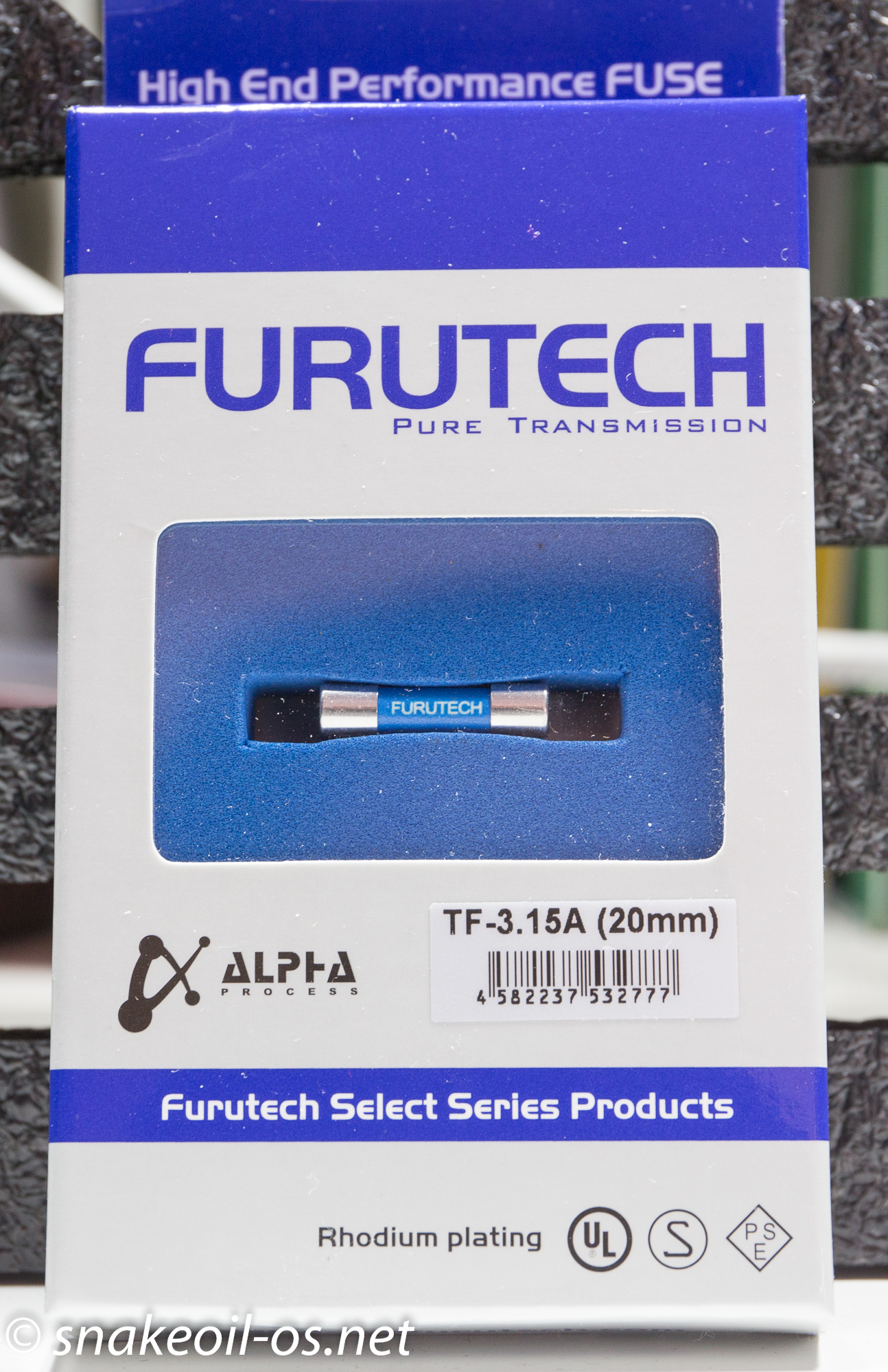
Whether fuse rolling is something you should consider is subjective. Read on to find out if audiophile fuses is a thing for you.
Is This For Me?
Let's get this out of the way first:
Yes, fuse rolling does influence the sound
The significance of this influence is entirely subjective and depends on the individual listener.
If you live in Australia and watched the season of Gruen (the season where they do "What Would Putin do" segments) and noticed a ground loop hum from the show; if you can still make out the hum even when the hosts are talking, then you are ready to do fuse rolling. Most people cannot hear this ground loop hum. Especially so when they are sitting a fair distance away from the speakers and while the hosts are talking.
The reason for this is simple - most people lack the active listening skills allowing them to sensitive to small "out of place" details in recordings. You do not need golden ears to do this, that is a myth. It's never about the ears, it's the muscle between the ears that count! The answer to active listening is really your brains, music listening is 100% cognition.
Train your brain and improve the sensitivity so that you start to break down the music the right way. Soon you'd learn to appreciate all the little details in the recording, and perhaps be able to notice when a track is in negative phase, or when the left/right channels are swapped. The key to this is learn to interpret the music, not to break it down and just hear for "better bass", "better mid range" or "better X". Learn to listen to music as music instead and you'd start to notice more and more details you otherwise wouldn't have.
The Snakeoil OS project will help you acheive this. But more on this later, right now let's talk about Furutech fuse!
Outside Packaging
Let's step back from the soap box and focus back on the Furutech fuse. This is the close up of the packaging up close. The packaging is certainly overkill given the fuse's dimensions is only 5 x 20 mm.

There are some text at the back of the packaging, briefly describing in detail the construction of the fuse. Perhaps you can use these to justify the price of this fuse to the MrsB)? The line of Japanese text looks really out of place here. 🙄.
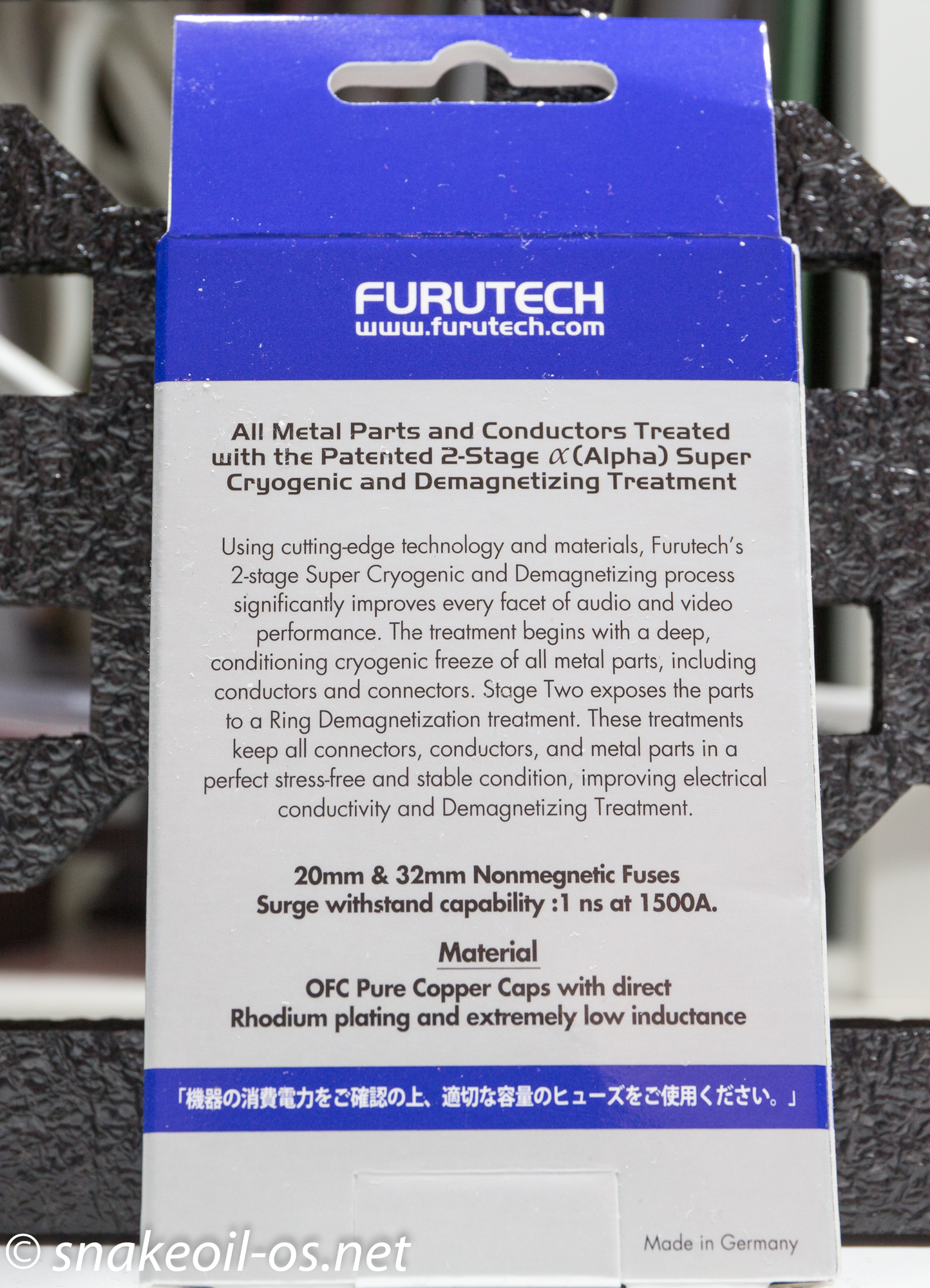
And here is the side view, nothing much to see here.
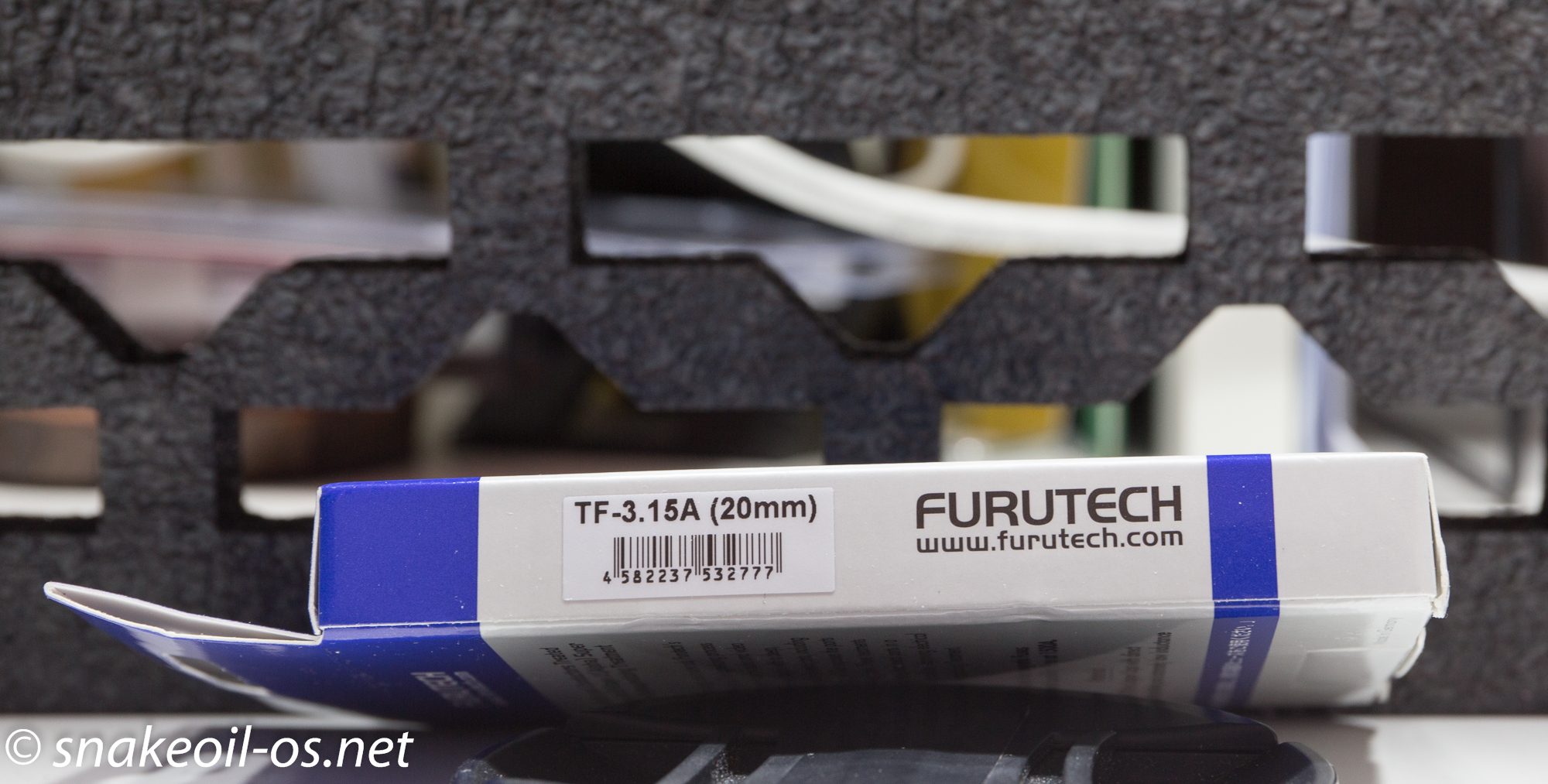
Let's peek what's inside.
Inside Packaging
And here is the fuse unpacked. This is really a lot of packing for a tiny fuse.
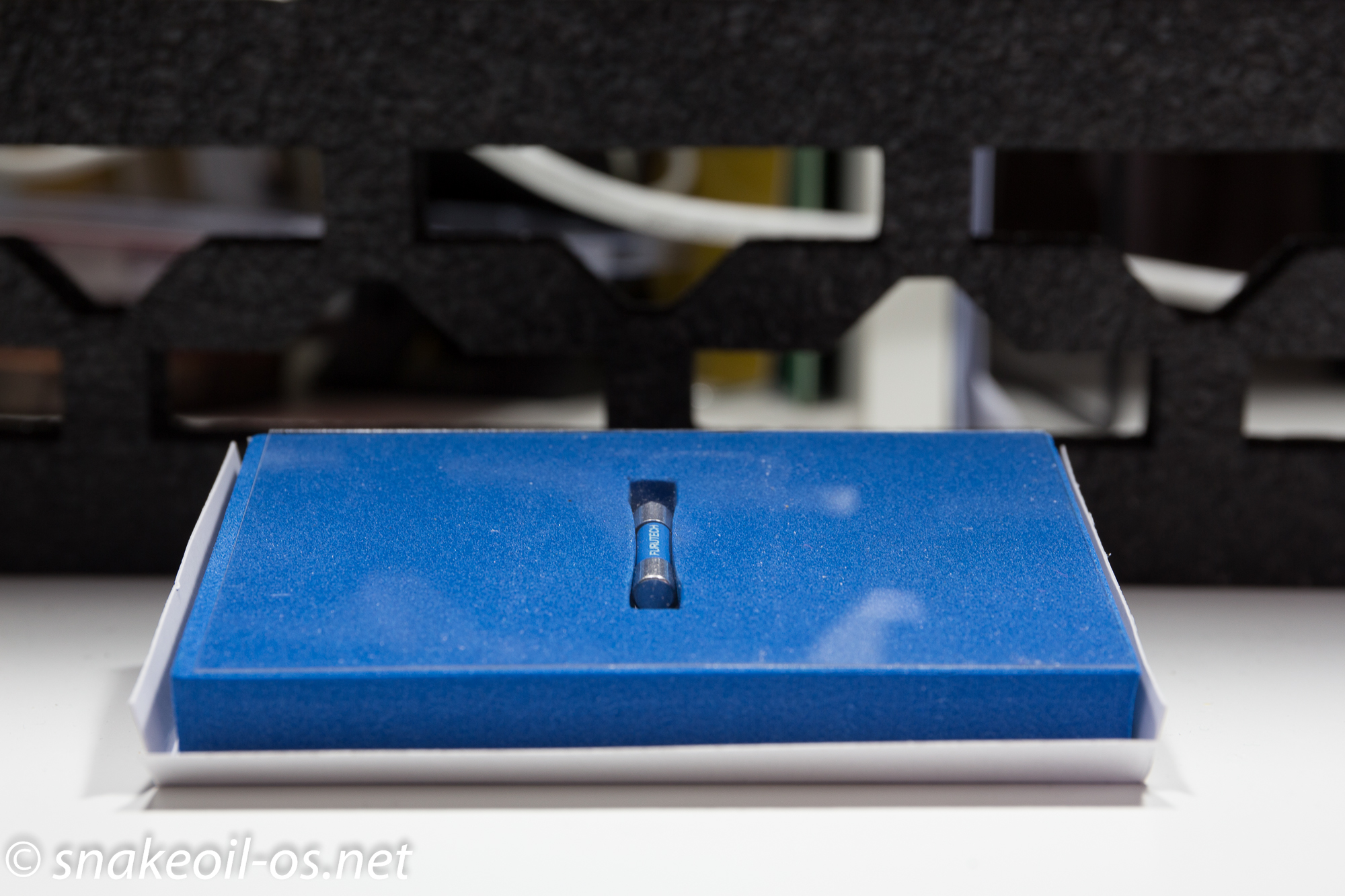
Being an eternal optimist I was hoping perhaps there is another 1 or 2 fuses hidden from view, nup, only one!
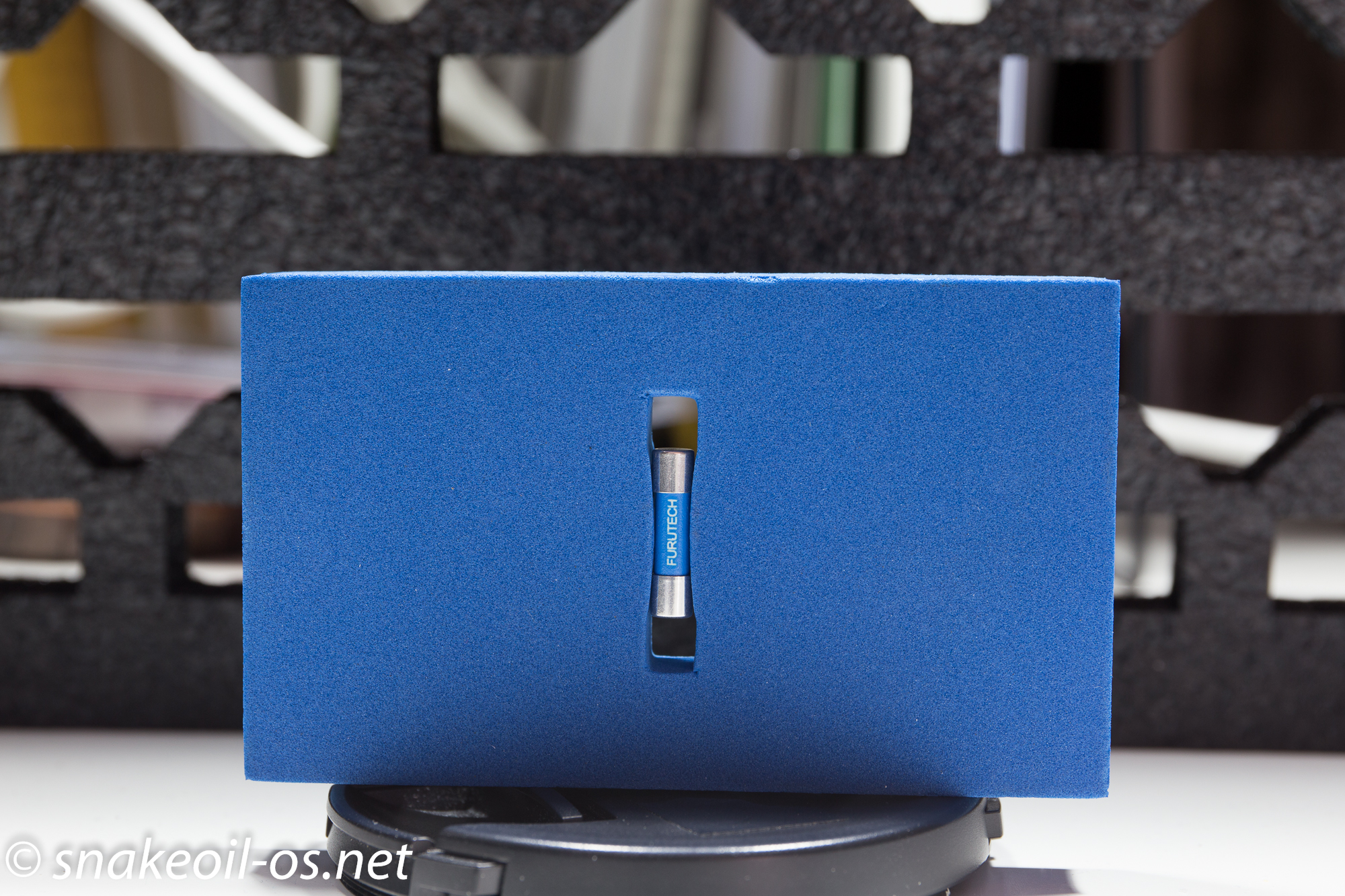
A macro shot of the fuse up close. Nothing else to say really, it's a fuse after all😅. Think about this for a moment, out there there is somebody with a job that involves lining up the fuse so that the word Furutech shows up perfectly in this packaging. If you are reading this and this is your job, I salute you!

The Furutech fuse is intended for my PS Audio P5 power re-generator. Shown here are the fuses I've experimented so far on the P5. From left to right:
- 5x20 AMR Audio 90% Silver alloy fuse tube 3.15 Amp slow blow.
- 5x20 Furutech TF 3.15 Amp
- Some random 5x20 fuse. This may or may not be the fuse that came with my P5. I removed the stock fuse and put it in a bin of fuses and can't tell which is which now.
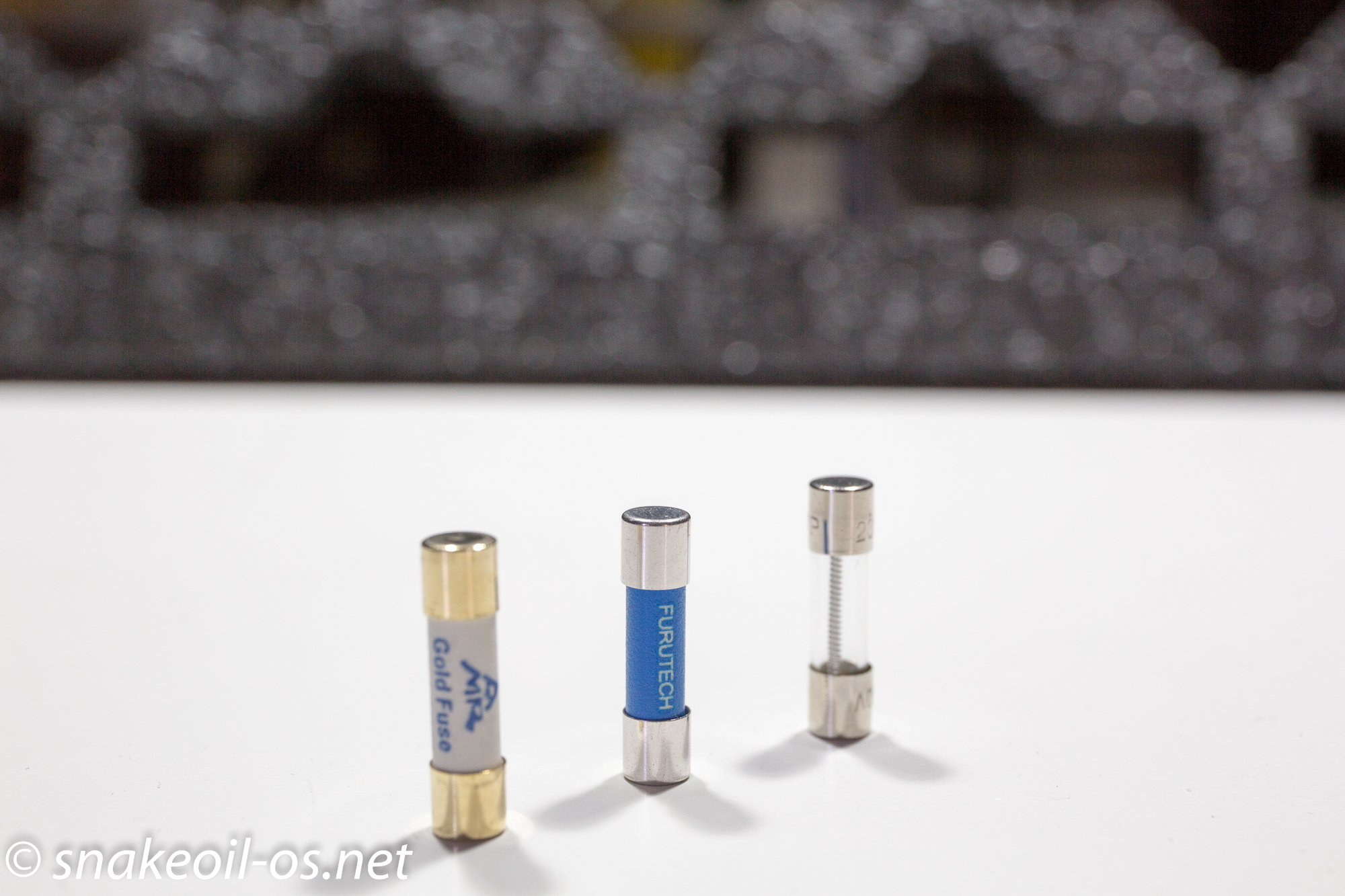
The stock fuse is the reference where the other 2 fuses are based upon. Long story short, the AMR brings more clarity and sweetness but all the low frequencies and weight disappeared. The Furutech has the same clarity and focus, but did not lose the weight. Overall I prefer the Furutech out of the 3 and this review will concentrate solely on the Furutech.
Read on for listening impressions!
Listening Impressions
| Track: | Sorry Seems To Be The Hardest Word |
| Artist: | Lydia Gray |
| Album: | Super Deluxe Sound |
| DR Score | 11 |

Acoustic music is my personal favorite and this song is one of my reference tracks. In this track all you have is the sweet vocals of Lydia Gray accompanied by a acoustic guitar, with a short violin interlude thrown in to for good measure. The whole experience is very intimate with a unplugged feel to it.
The music begins with a short guitar intro, and Lydia's voice leads in at the 20 second mark. For me I find the Furutech fuse improves on clarity and focus, and these two improvements made the guitar sound more intimate now. This new intimacy revealed to me for the first time just how important this short 20 seconds is all about. It's hard to put it down in words, but in essence the 20 seconds sets up the listener for the entire mood of the entire track.
With the Furutech fuse in place, it's now easier for me to tell the relative position of where everything is on the sound stage. e.g. I can tell Lydia's voice is fixed in the center, with the guitar on the center right, slightly recessed. The guitar and vocals do not seem to play off and interact with one another, suggesting to me this is a studio album.
Now is it just me? Why am now I getting the vibe that the violin interlude is actually symbolism of a guy apologizing to the woman? The solo is charming and sincere, and yet almost feels like empty words at the same time. Does not quite make sense though given the lyrics 😑.
So far this simple track is telling me a lot about the fuse:
- Better clarity
- Easier to focus and localise where all the sound comes from in the sound stage (pin point imaging)
- Easier to discern the difference in distance between different point sources in the 3D sound stage (image depth)
- Improvement in timbre
| Track: | Spanish |
| Artist: | Unknown |
| Album: | TIS HD Mastering |
| DR Score | 8 |
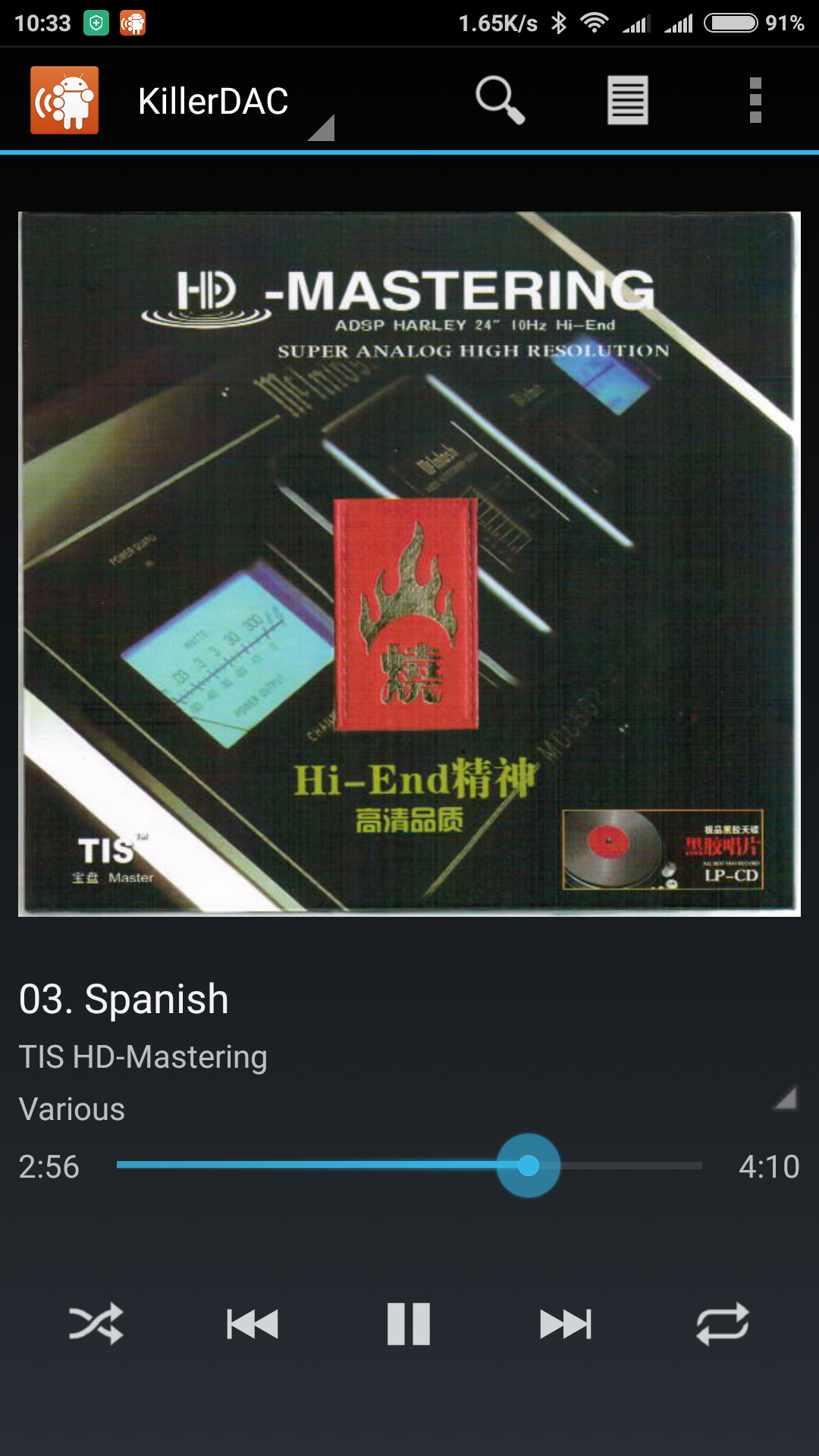
This is one of those tracks with surround sound like effects in the mix, when the crowd starts cheering, their cheers fill up the entire room. The music from the main guitar (classical guitar?) in the center is very focused and there is a certain physical precision to it. The supporting guitar is more to the left, and located further behind. The timbre between the two guitars are different is more distinct now compared to before. All the instruments are pretty well defined and clearer. There is a physical realness to these two guitars, completely making the speakers (and eletronics) disappear. There is only music and nothing else.
As the performance end, people begin to talk again, and here the sound effects expanded vertically more than before. There is a lot more height now.
| Track: | Dancing Doll |
| Artist: | Unknown |
| Album: | TIS HD Mastering |
| DR Score | 8 |
This is another interesting special effects track. The alarms/buzzers at the beginning of the track will almost fool you into thinking they exist physically inside your room.
The start of this track gave me the impression people are waking up from sleep, and it's going to be a busy work day. As they are about to go about their daily grind (some people are probably already late given the alarms of their watches has gone off), there is this guy playing the Saxophone (imagine this is happening in a train station and the guy is bustling early in the morning?)
Everything about the daily grind stopped as the busker starts playing, the sexy saxophone transports everybody into a completely new world, away from the modern world. The saxophone is very intimate, powerful and the notes fill up the entire room. Pay extra attention to the echos made by this saxophone.
And from these two tracks, I reckon:
- Better surround sound effect, especially no tracks where the speakers completely disappear and there are no imaging "holes" anywhere
- A lot more image height
- Makes you believe the playing elements are actually present inside your listening room
- It's easier to listen for "the recording space"
| Track: | It Was A Very Good Year |
| Artist: | Ray Charles |
| Album: | Genius Loves Company |
| DR Score | 11 |
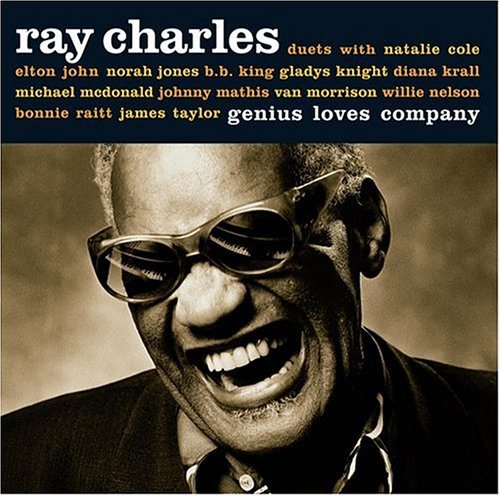
If you already have the necessary active listening skills to discern the ground loop hum on TV shows this track will be something you should be interested in. Somewhere along the 2:30 mark (the timestamp is just a rough guide) you will hear a weird artifact. There is a small background noise located some where along the left hand side of the sound stage. Try and guess what that sound is!
This artifact is present in all the mixes I own - CD, SACD and HDTracks. As such it may well be possible the sound is recorded in the original master and missed by the recording engineer, and not from post processing in the later mastering stages.
I always stress the most important component in your audio system is you the listener (your system is only as good as your active listening skills). The truth is the audio system and you goes hand in hand - your audio system needs to cut the mustard too. If your audio system makes a sound, you must have the skills to be able to hear it. The average system is not resolving enough to reproduce this artifact. And those that can, not everybody can hear it. I have personally demonstrated this track on systems that are capable of generating this artifact, and everybody missed this.
With the Furutech fuse, the artifact to me sound very much like a soft sneeze. The actual artifact could well be something else, I'm just letting my imagination do the talking.
Willie's Nelson's voice is really an acquired taste I reckon, but his vocals is surreal here. The southern American accent is something I admitted I never noticed before, and that accent is really difficult to miss now. There are heaps more details everywhere, and I'm still blown away by Ray Charles's larger than life, and very charismatic voice.
So in this track, I'm:
- more aware of details in the recording I'm previously unaware of
- getting better timbre from the supporting musical instruments
| Track: | 猜不透 |
| Artist: | 鐘明秋 |
| Album: | 溫文爾雅-鑽石男聲篇(紫銀合金AQCD) |
| DR Score | 8 |

This track is similar to the It Was A Very Good Year track as it includes artifacts that was missed by the audio engineer. At around the 0:30 mark, when the male vocals start to sing, did you notice the rhythmic beats, possibly from a metronome?
This artifact from this timestamp is as easy to spot as the Ray Charles track earlier. Here's a surprise for you, the same metronome actually appeared earlier, albeit at a much softer volume. In this first instance, previously I can only detect three beats before the music drowned it away. Now I can hear four distinct click, and possibly a fifth.
So in this track:
- Make out details that are recorded at levels that are close to the noise floor
- Highlight the vocals well, allowing me to listen to the little naunces of the vocals
That's all the listening for now, time for some final notes.
[adsense:]
[pagebreak]
Final Notes
The only reason why I've decided to start fuse rolling on the PSAudio P5 first is because this unit has a very easy to handle fuse holder mechanism (remove the holder by a simple twist). Almost everything else I own requires me to either open up the unit itself (e.g. the Marantz SA-11S2), or pry the fuse holder from the IEC inlet with a flat head screw driver.
On hindsight swapping the fuse of the P5 is a great idea as that fuse powers the entire audio system - every audio equipment is powered from the PSAudio P5. Swapping this fuse ensures every component will benefit. Having said that, what will it be like if I swap the fuse further down the chain, e.g. on the JS-2? Will that yield even bigger benefits, or would it be a furby? In time I will try that and see how that goes.
If you're wondering if I am imaging all these improvements, of course I am! As I mentioned earlier, music interpretation is 100% cognition! Instead of focusing on what you can hear from the sound waves, focus more on what you can feel from the music:). Do the latter and you'd open yourself to a whole new world (and probably a lot of flame wars too).
This is my first review where I explain in more detail on how I listen. The quick story is I have a list of reference tracks that I listen to almost daily, and I have listened to these tracks for years (revising and honing the list along the way). As shown in this example the tracks don't necessary need to be audiophile level recordings, the key is you need to familiarize yourself to these tracks so as you'd pick up new things, or notice existing things aren't there any more . If you're intrigued to learn more, check out for the "How To Listen" chapter in the manual in a few months time.
Conclusion
The importance of a passive component like a fuse is akin to finding out the length of a piece of string. It all depends on the context, some will find rolling fuses essential while others will find they get better rewards from something else.
For those who has an intention to do fuse rolling, here's a quick summary of the potential benefits of the Furutech:
Pros:
- you'd have a better perception of depth
- Better imaging
- Better clarity
- Quieter background
- Improvement in timbre
Cons:
- Perhaps a bit on the "bright" side? (Most will say this is an improvement in detail though)
- It is still an expensive piece of kit
Be warned though this is a YMMV thing as there are so many variables to consider. It is entirely possible that you can spend good money on the fuse and get zero benefits out of it. System synergy and knowing where the weaknesses are in yourself and the audio system are important factors to consider as well, e.g. if your system has too much bass the AMR fuse may well be the better option here.
Do not buy a fuse as "insurance" thinking you may enjoy the benefits later. Only make changes to your system when it gives you a definite improvement. If you can, borrow this fuse and test it in your system first before making any decision.
Review Gear
This review is written based on the following gear:
- Marantz SC-11S1 pre-amplifier
- Marantz SM-11S1 power amplifier
- Audio-GD DI-2014
- Furutech GT-2 USB
- KillerDAC
- Jetway NF9C running Snakeoil OS (v1.4.0 with Squeezlite 1.64 only)
- JS2 power supply with Hashimoto Choke, Hashimoto Transformer and Jensen caps
- Kimber SilverStreak XLR
- Achtung silver RCA
- PSAudio P5 (Furutech fuse)
- ClearAudio Diamond power cables
- Sine world GPO


Comments
Totally agreed with your…
Totally agreed with your review. Having installed and lived with two small Furutech fuses for 24 hours (obviously not burned in yet), I’ve found them to possess those characteristics that you described.
I’ve seen more expensive fuses advertised else where, so I think these Furutech are pretty cost effective especially for what they do to our gear. Thanks for the good work.
Placebo.
Placebo.
As i changed the amp and dac…
As i changed the amp and dac inlets to furutech Fi-09 and sow a justification for the investment/84€ each; will look ahead for the fuse. Thanks for the in-depth review.
So you’re basically saying…
So you’re basically saying you need to be willing to expect improvements if you are going to roll fuses. That is exactly how the placebo effect works. This primes you to hyper focus on details until your brain tells you there is a difference. This renders all findings anecdotal, at best. Snake oil thrives in these conditions.
Please perform a proper blind actual ABX test performed. This will not only show if there’s a difference, it will also show which one is preferred. The null hypothesis needs to always be that there is no difference.
Hi Frans, I think you’ll…
In reply to So you’re basically saying… by Frans (not verified)
Hi Frans,
I think you’ll hate my views on Blind Testing then (https://www.snakeoil-os.net/news/folklore/folklore-3-blind-testing).
For me personally I am embracing placebos. I’m all for placebos IF it is giving me genuinely enjoyment when I’m listening to the music. At the end of the day, I’m not listening to "difference in music", I’m looking for "difference in my enjoyment when listening to music".
You may well be surprised how much more enjoyable you’ll get from your sound system if you start focusing on that.
I avoid deluding myself; it…
In reply to Hi Frans, I think you’ll… by agent_kith
I avoid deluding myself; it makes my opinions worthless for others and my conscience will not allow it. I A/B test for a living and know the value.
If I can measurably detect a difference with a tweak or gear - I am willing to spend money. If I cannot, I move on to something where I can. It’s simple really. The placebo greatly undermines your resource allocation.
Recently, I regret getting an Uptone EtherRegen and not returning it within the window (due to outside circumstances). The damn thing does nothing at all except generate heat.
That is some good advice…
In reply to I avoid deluding myself; it… by Fran (not verified)
That is some good advice Frans. Like you I always maintained my opinions are worthless to others. This is why the motto of Snakeoil OS is - Music Your Way, Designed By Us Defined By You.
The subject (music listener) is the litmus test and is what matters. If you use A/B or ABX tests and find it works for you, then good for it. At the end of the day, it’s music your way (i.e. defined by you).
And yes, you basically nailed my approach to Hifi in the first sentence, I’m indeed trying to delude myself. After all I am doing everything I can to reproduce music to trick my brains into thinking something fake (a recording) is something real (a real life person performing in front of me). We all know what an optical illusion is, I’m effectively doing an audio illusion. The key thing is that audio illusion is only very likely work for me and me alone. If you drop by and listen to my setup, it’s very unlikely you’d experience the same effects I do.
I have never tried EtherRegen, although I do own a Uptone power supply. To be honest I don’t change my Hifi equipment that often, havn’t changed a thing in well over 10 years (probably more). My focus always has been making my current system better. 10+ years in I estimate I’ve only managed to bring out maybe 70% of the performance out of my sound system. My current focus is still on trying to bring something more out of my current equipment. The only upgrade I would do right now is if I can find a matching second pre-amp + amp (SC11 and SM11) and split my left and right channels (i.e. one pre-amp and amp for left, and another for right).
Add new comment